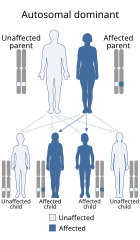Shprintzen–Goldberg syndrome
| Shprintzen–Goldberg syndrome | |
|---|---|
| Other names | Marfanoid craniosynostosis syndrome[1] |
 | |
| Shprintzen–Goldberg syndrome is inherited in an autosomal dominant manner | |
Shprintzen–Goldberg syndrome is a multiple anomaly syndrome that has craniosynostosis, multiple abdominal hernias, cognitive impairment, and other skeletal malformations as key features. Several reports have linked the syndrome to a mutation in the FBN1 gene, but these cases do not resemble those initially described in the medical literature in 1982 by Shprintzen and Goldberg,[2] and Greally et al. in 1998 failed to find a causal link to FBN1.[3] At this time, the cause of Shprintzen–Goldberg syndrome remains uncertain. The syndrome is rare with fewer than 50 cases described in the medical literature to date.[citation needed]
See also[]
References[]
- ^ RESERVED, INSERM US14-- ALL RIGHTS. "Orphanet: Shprintzen Goldberg syndrome". www.orpha.net. Retrieved 22 October 2019.
- ^ Shprintzen, RJ; Goldberg, R (1982). "A recurrent pattern syndrome of craniosynostosis associated with arachnodactyly and abdominal hernias". Journal of Craniofacial Genetics and Developmental Biology. 2 (1): 65–74. PMID 6182156.
- ^ Greally MT, Carey JC, Milewicz DM, Hudgins L, Goldberg RB, Shprintzen RJ, Cousineau AJ, Smith WL Jr, Judisch, GF, Hanson JW (1998). "Shprintzen-Goldberg syndrome: a clinical analysis". American Journal of Medical Genetics. 76 (3): 202–212. doi:10.1002/(SICI)1096-8628(19980319)76:3<202::AID-AJMG2>3.0.CO;2-S. PMID 9508238.
External links[]
| Classification | |
|---|---|
| External resources |
Categories:
- Congenital disorders
- Rare syndromes
- Disease stubs
- Human reproduction stubs